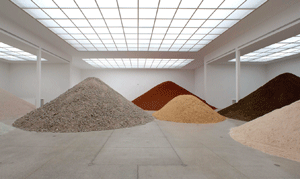Make a stand… and deliver
Michaela Crimmin reviews how artists are making a physical difference to the environment

The casual consumerism of rich nations, population increase, the extraction of natural resources that will never be replaced and the consequent social ramifications for the poor of the world, present a significant range of challenges, eliciting a multitude of responses from artists. These range from the confrontational to the problem-solving; from rendering the beauty of the natural environment and appealing to our better instincts, to commenting on our dislocation from it and raising questions as to why we are not living in a way that is more sustainable, egalitarian and just. Artists are bringing new insights to the challenges facing the world at large. Two ongoing projects that speak extraordinarily of our environment from very different viewpoints are Lara Almarcegui’s examination of urban transformation and change across the Westernised world; and EXYZT’s ‘Dalston Mill’ in London’s East End.
One aspect of Almarcegui’s work centres on measuring. In one sense a precursor to the launch of the Green Guide at this year’s Frieze Art Fair, two years ago at Frieze she presented an analysis of the construction materials used in making the exhibition space, the analysis confronting each visitor as they entered the building. Her work reveals what is often hidden or invisible, and especially focuses on the value of disused parking lots, wastelands, the peripheral – those abandoned places that we fail to register. She delves into the histories of each site, makes publications and exhibitions of their stories, but she never seeks to change the actual places.
Almarcegui works with their owners to open them up – removing a gate here, taking away a fence there, elbowing through the bureaucracies. The result of this work is a means of thinking afresh about space, encouraging us to pause and to consider whether we are prepared to lose these places forever. Waiting in the wings are often high-rise buildings that will consume energy at a rate that is simply not sustainable. Therefore an important part of Almarcegui’s work is an act of prevention and an implicit encouragement to reconsider ‘progress’.
The collective EXYZT have been employing a more overt approach. Working with muf (the UK’s representative at this year’s Venice Architecture Biennial) and landscape architects J&L Gibbons, a piece of land, this time in London’s East End, has become an alternative to the encroaching developments that are in danger of engulfing it. As part of the Barbican Art Gallery’s ‘Radical Nature’ exhibition, EXYZT recreated a small version of Agnes Denes’ Wheatfield (planted in Battery Park New York in 1983), built a temporary wind turbine, set up a flour mill, an oven and a bar, and encouraged people to participate in events, and to bring their own ideas and contributions. Seventeen thousand people visited over three weeks and experienced this demonstration of the natural cycle of growing, reaping, and eating and drinking together. Such was the success of the project that EXYZT have been back on site this summer establishing Dalston Mill as a long-term initiative, proving that sustainability is far from sackcloth and ashes and instead a viable, creative and participatory prototype for public space.
Join the Discussion
You must be logged in to post a comment.